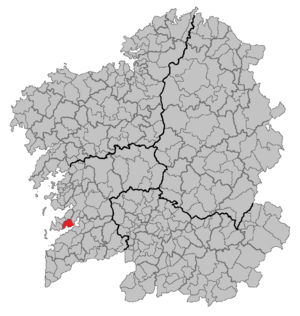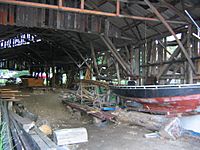Moaña facts for kids
Quick facts for kids
Moaña
|
|||
|---|---|---|---|
|
|||

Location of Moaña
|
|||
| Country | |||
| Autonomous community | |||
| Province | Pontevedra | ||
| Comarca | O Morrazo | ||
| Founded | 1836 | ||
| Area | |||
| • Total | 31.5 km2 (12.2 sq mi) | ||
| Population
(2018)
|
|||
| • Total | 19,448 | ||
| • Density | 617.4/km2 (1,599.1/sq mi) | ||
| Demonym(s) | Moañés, -esa | ||
| Time zone | UTC+1 (CET) | ||
| • Summer (DST) | UTC+2 (CEST) | ||
| Postal code |
36950
|
||
Moaña is a town located in Galicia, Spain. It is part of the Pontevedra province. In 2018, about 19,448 people lived there.
Moaña is one of five towns on the O Morrazo peninsula. This peninsula separates two important sea inlets called rias: the Ria of Vigo and the Ria of Pontevedra.
The coast of Moaña has many beautiful beaches. The area is known for both tourism and traditional seafood farming. In the sea nearby, people grow mussels, oysters, and other seafood. It's also a great place for sea sports. The Rande Bridge connects Moaña to the town of Redondela. This area was once the site of a famous sea battle, the Battle of Vigo Bay. Moaña also has a lively cultural scene, including the Interceltic Festival of Morrazo and many local celebrations.
Contents
History of Moaña
The first signs of people living in Moaña date back a very long time, around 75,000 BC. Tools made of flint and remains of old settlements have been found in areas like Domaio, O Carme, Meira, and Tiran. These finds show that people lived here from the Stone Age up to the Middle Ages.
Special pottery from the Beaker culture was found here for the first time in Galicia. Tools and weapons made of copper and bronze were also discovered. You can even see ancient rock carvings, called petroglyphs, in Tiran. The Castro culture, which built fortified villages, was very common here. There are also many signs that the Romans influenced the area.
In the Middle Ages, Moaña was controlled by the bishop of Santiago de Compostela. In the 7th century, attacks by the Normans caused many people to leave the Morrazo area. But by the 12th century, the population grew again. This happened after Archbishop Diego Gelmírez created a plan to protect the coast. Churches like San Martino and San Xoán of Tiran were built around this time. Later, powerful families like the Meira and Soutomaior took control. The Meira Tower was even destroyed during the Irmandiño Wars (1467–1469), a time of peasant revolts.
In the 17th century, the introduction of maize (corn) changed the local economy. About 90% of the farmland was used to grow corn. This led to many watermills being built along the rivers. Fishing has always been very important to Moaña's economy. When business people from Catalonia arrived in the 17th century, they started the fish canning industry. This helped the town grow a lot, both in population and wealth.
In 1702, the Battle of Vigo Bay (also known as the Battle of Rande) took place. British and Dutch forces attacked and looted Domaio, Meira, and Tiran. A hundred years later, in 1809, battles were fought in this area against French invaders.
Moaña's Climate
Moaña has a mild oceanic climate. This means the temperatures are not too extreme. The average yearly temperature is about 15 °C (59 °F). The area gets a good amount of rain, usually between 1300 and 1500 mm (51-59 inches) per year.
Economy and Jobs
Moaña's economy has always been closely linked to the sea. Many jobs, from fishing to industry and services, depend on the ocean.
About 24.4% of the working people (data from 2006) are involved in the primary sector, which is mainly fishing. The secondary sector, which includes industries, employs 39% of the workers. Key activities in this sector are building, shipyard work, and canning seafood. The services sector, with 37% of the working population, focuses on shopping and tourism. Moaña has a golf course and three pleasure harbors for visitors.
Waterways and Beaches
The entire southern edge of Moaña is coastline. There are rocky cliffs and beaches stretching from the Rande strait to the town of Cangas. The cliffs are not very high, and small beaches can be found at their base. Larger beaches are located in the inlets.
Popular Beaches
Here are some of the most popular beaches in Moaña:
- A Xunqueira Beach: This beach is right in the town center. It's surrounded by a park and sports facilities.
- O Con Beach: Located between Moaña's main dock and Cortés cape. It has good quality sand and is a Blue Flag beach, meaning it meets high standards for water quality and facilities.
- Canabal Beach or Germans' Beach: Found in the parish of Tirán, this is a very peaceful spot. There's a local story that German soldiers lived here during World War II.
- Domaio Beach: Located next to the Domaio dock.
- Meira Beach: Next to A Xunqueira beach, between Saint Bartolome's Island and the coast of Meira.
- Raven's Nest Beach (Praia do Niño do corvo): A small beach at the bottom of a short cliff in Tirán.
- A Borna Beach: Located in the parish of Domaio.
- Videira Beach: Located in the parish of Tirán.
Rivers and Streams
Moaña has several rivers and many smaller streams. Some important ones include:
- A Fraga's River or Thieve's River: This is the longest river in the municipality. It starts in Xaxán Mountain and flows into A Xunqueira beach. It has several small, deep pools and waterfalls. There's a Watermill’s Route along this river, where 31 old watermills have been restored. Three of them are still working!
- Freixa's River
- Hell's River
- Miñouba River: This river starts in Faro Mountain in the parish of Domaio. It has a famous deep pool called Moura's deep pool.
- Ravine's River
Monuments and Places to Visit
Moaña offers many interesting places to explore:
- Country House of O Rosal (Pazo do Rosal): This is a beautiful example of civil architecture from the late 18th century. A famous rear admiral, Casto Méndez Núñez, is buried in its chapel.
- Dolmen of Chan Da Arquiña: This important ancient stone monument is over 5,000 years old. It's located near Mount Faro, which is the highest point in Morrazo (622m high). The dolmen has a polygonal chamber made of eleven upright stones and a corridor. Old tools and pottery fragments were found here.
- Moaña Leisure Harbour: A great place to enjoy sea sports like sailing or sport fishing.
- Saint Martin's Church (Igrexa de San Martiño): Built in the 12th century, this church is one of the best examples of Romanesque art in Galicia.
- Saint John of Tiran's Church: A small church built in the 13th century, showing a mix of late Romanesque and Gothic art styles.
- Saint Eulalia of Meira's Church: A beautiful Baroque-style church.
- Water Mill Route: This walking path is 6 km long and follows the river's bank. It goes through a lush Atlantic forest. Thirty-one old watermills have been restored along this route, and three of them are still active.
Sports in Moaña
Rowing is a very popular sport in Moaña. There are two active rowing clubs: S.D. Samertolameu (from Meira) and S.D. Tirán. Both clubs compete at the highest level.
In 1960, a team made up of the best rowers from both clubs, competing as Moaña, won the Spanish Rowing Championship. Later, the S.D. Tirán club won this competition three more times in 1961, 1996, and 1997.
Sister Cities
Local Parishes
Moaña is divided into several smaller areas called parishes:
- Domaio
- Meira
- Moaña
- Tirán
Famous People from Moaña
- Casto Méndez Núñez, a Spanish rear admiral
- Santiago Castroviejo, a botanist
- Anxo Lorenzo, a piper (plays bagpipes)
- Jonathan Aspas, a football player
- Iago Aspas, a football player
- Dani Rivas, a motorcycle racer
Images for kids
See also
 In Spanish: Moaña para niños
In Spanish: Moaña para niños




















